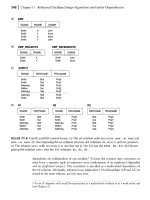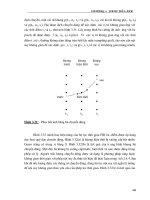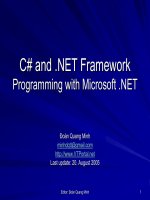mcgraw hill wireless data demystified phần 10 docx
Bạn đang xem bản rút gọn của tài liệu. Xem và tải ngay bản đầy đủ của tài liệu tại đây (485.33 KB, 62 trang )
Chapter 23: Summary, Recommendations, and Conclusions
demonstrated to provide reliable wireless data rates exceeding 100 Mbps
within buildings, with extremely low power spectral densities.
Another exciting development, particularly applicable to home or cam-
pus wireless data distribution, is the commercialization of orthogonal
frequency-division multiplexing (OFDM). OFDM offers multiple access
and signal processing benefits that have not been available in previous
modulation methods. It allows wireless data networks to pack high spec-
tral efficiency into relatively small spectrum bandwidths. This is similar
to how digital subscriber line (DSL) technology allows high wireless data
rates to be passed through low-bandwidth copper cables. IEEE 802.16
point-to-multipoint MAN wireless data networks certainly could provide
tetherless broadband access in the local loop, and are already doing so in
developing nations.
New discoveries in the 1990s have shown us how to exploit the spa-
tial dimension of wireless data channels through the use of multiple
antennas at the transmitter and receiver, where significant gains in
either energy efficiency or (more important, perhaps) spectral efficiency
can be obtained. Pioneering work showed that the theoretical wireless
data rates obtained with such systems in an independent Rayleigh scat-
tering environment increase linearly with the number of antennas, and
these rates approach 90 percent of the theoretical maximum Shannon
capacity. New space-time methods have been shown to offer more than
an order of magnitude of increase in spectral efficiency over today’s mod-
ulation and coding techniques used in current WLANs and cell phone
systems, and these methods hold promise for wireless data networks of
the future. As an example, Lucent’s V-BLAST laboratory prototype sys-
tem was demonstrated to provide spectral efficiencies of 20 to 40 bps/Hz
at average signal-to-noise ratio ranging from 24 to 34 dB in an indoor
environment, and potential capacities on the order of 60 to 70 bps/Hz
were demonstrated at 30-dB S/N using 16 antennas at both the trans-
mitter and receiver.
Now, let’s explore in more detail some of the exciting technologies pre-
viously listed, and postulate how they may be deployed in networks of
the future. Some of these new technologies will require new spectrum
allocations in order to succeed, and some may exploit already congested
spectrum through the promise of greater capacity. Yet, some of these
ideas may still be ahead of their time, and may need to wait another
decade or so to gain widespread acceptance.
Indoor Access: The Wireless Data Frontier
It is only when sitting, studying, or concentrating that human beings are
most able to use large bandwidths, and this activity happens primarily
509
510
Part 5: Advanced Data Network Solutions and Future Directions
inside buildings. Just like watching a movie or television, the absorption
of wireless data is primarily a passive activity, occurring at home or at
work while you sit or stand in a pseudostationary position. Yet, the
entire wireless data industry, as you know it today, was originally devel-
oped for mobile voice users, for people traveling in cars between home
and work, before the Internet was even available to the public.
Internet usage has exploded because of consumer and business adop-
tions inside buildings using fixed connectivity provided by Internet
service providers (ISPs) that team with a local exchange carrier, a long-
distance company, or a cable company to gain access to each home. By
stark contrast, wireless data carriers have spent huge amounts of capital
to purchase spectrum licenses and to deploy infrastructure for outdoor
mobile coverage, and have historically had difficulty penetrating their sig-
nal into buildings or homes. Furthermore, all current second-generation
digital wireless data technologies were developed with a voice-centric
architecture, before the widespread acceptance of the Internet, leaving
all wireless data carriers vulnerable to each other and to alternative
providers who can provide reliable voice and wireless data service into
buildings. The battle for indoor wireless data access, where broadband
data will be most needed and wanted, is shaping up to be one of the
most important industry issues in the coming decade. Cellular and PCS
operators desperately need third-generation Web-centric wireless data
equipment that can provide Internet-like capabilities in the hands of its
consumers inside buildings, as much to reduce subscriber churn as to
offer new services, yet most carriers do not have existing infrastructure
to provide indoor coverage or capacity reliably for today’s more primitive
cellular technology. This offers an opening for a new type of competitor
that can exploit the availability of low-cost, license-free wireless LAN
(WLAN) equipment.
By using the existing wired Ethernet infrastructure within a building
or campus, WLANs are being deployed rapidly and inexpensively today,
providing tetherless computer access with wireless data rates over an
order of magnitude greater than those promised by much more expen-
sive 3G cellular equipment. As voice over IP technology is improved, it is
conceivable that WLANs could offer mobile/portable wireless data ser-
vice that integrates phone-like features with Internet access throughout
a campus without any reliance upon the cellular infrastructure.
Today, many early stage companies are looking at ways to integrate
2.5G and 3G cellular technology with WLAN technology, in order to pro-
vide coverage and capacity distribution systems for any carrier that
wishes to penetrate campuses or buildings. Phones are now being built
that combine WLAN and cellular capabilities within them, as a way to
ensure connectivity for either type of indoor service.
Chapter 23: Summary, Recommendations, and Conclusions
Dual-mode chip sets for cellular mobile and WLAN are already becom-
ing available from Nokia and other sources, and Intel and Microsoft (two
titans steeped in software and semiconductors) recently announced a joint
venture to make a new generation of cell phone. Where in-building wire-
less data connectivity is concerned, WLANs and their existing, widely
installed IP-based wired network infrastructure may soon become a seri-
ous contender to the radio-centric cellular/PCS carriers of today who are
just now seriously addressing the need for connectivity and capacity
inside buildings. Moreover, WLANs are extending to campus-size areas
and in outdoor venues such as tourist attractions and airports.
Multiple Access: The Universal Acceptance
of CDMA
Code-division multiple access (CDMA) allows multiple users to share the
same spectrum through the use of distinct codes that appear as noise to
unintended receivers, and which are easily processed at baseband for
the intended receiver. The introduction of CDMA seemed to polarize ser-
vice providers and network system designers. On the one side, there
were those who saw CDMA as a revolutionary technology that would
increase cellular capacity by an order of magnitude. On the other side,
there were the skeptics who saw CDMA as being incredibly complex,
and not even viable. While CDMA did not immediately realize a tenfold
capacity increase over first-generation analog cellular, it has slowly won
over skeptics and is the clear winner in the battle of technologies, hav-
ing emerged as the dominant technology in third-generation cellular
standardization (see Fig. 23-1).
1
Furthermore, CDMA techniques have
also been adopted for many consumer appliances that operate in unli-
censed bands, such as WLANs and cordless phone systems. Early indi-
cations are that ultra-wideband technology may also rely on CDMA for
multiple access, thereby completing the domination of CDMA as a wire-
less data technology.
Wireless Data Rates: Up, Up, and Away!
The next decade (starting in 2010) will finally see high-speed wireless
data come to maturity. A key to making this a reality will be spectral
efficiencies that are an order of magnitude greater than what is seen
today. At the Physical layer, three technologies will play a role in achiev-
ing these efficiencies: orthogonal frequency-division multiplexing, space-
time architectures, and ultra-wideband communications.
511
512
Part 5: Advanced Data Network Solutions and Future Directions
Orthogonal Frequency-Division Multiplexing
and Multicarrier Communications
Orthogonal frequency-division multiplexing (OFDM) is a special form of
multicarrier transmission in which a single high-speed wireless data
stream is transmitted over a number of lower-rate subcarriers. While
the concept of parallel wireless data transmission and OFDM can be
traced back to the late 1950s, its initial use was in several high-frequency
military systems in the 1960s such as KINEPLEX and KATHRYN. The
discrete Fourier transform implementation of OFDM and early patents
on the subject were pioneers in the early 1970s. Today, OFDM is a
strong candidate for commercial high-speed broadband wireless data
communications, as a result of recent advances in very large scale inte-
gration (VLSI) technology that make high-speed, large-size fast Fourier
transform (FFT) chips commercially viable. In addition, OFDM technology
possesses a number of unique features that make it an attractive choice
for high-speed broadband wireless data communications:
OFDM is robust against multipath fading and intersymbol
interference because the symbol duration increases for the lower-
rate parallel subcarriers. For a given delay spread, the
implementation complexity of an OFDM receiver is considerably
less than that of a single carrier with an equalizer.
OFDM allows for an efficient use of the available radio-frequency
(RF) spectrum through the use of adaptive modulation and power
allocation across the subcarriers that are matched to slowly
varying channel conditions using programmable digital signal
processors, thereby enabling bandwidth-on-demand technology and
higher spectral efficiency.
OFDM is robust against narrowband interference, since
narrowband interference only affects a small fraction of the
subcarriers.
Unlike other competing broadband access technologies, OFDM
does not require contiguous bandwidth for operation.
OFDM makes single-frequency networks possible, which is
particularly attractive for broadcasting applications.
1
In fact, over the past decade, OFDM has been exploited for wideband
data communications over mobile radio FM channels, high-bit-rate digi-
tal subscriber lines (HDSL) up to 1.6 Mbps, asymmetric digital sub-
scriber lines (ADSL) up to 6 Mbps, very high speed subscriber lines
(VDSL) up to 100 Mbps, digital audio broadcasting, and digital video
broadcasting. More recently, OFDM has been accepted for new wireless
Chapter 23: Summary, Recommendations, and Conclusions
local-area network standards, which include IEEE 802.11a and IEEE
802.11g, providing data rates up to 54 Mbps in the 5-GHz range, as well
as for high-performance local-area networks such as HiperLAN2 and
others in ETSI-BRAN. OFDM has also been proposed for IEEE 802.16
MAN and integrated services digital broadcasting (ISDB-T) equipment.
Coded OFDM (COFDM) technology is also being considered for the
digital television (DTV) terrestrial broadcasting standard by the Federal
Communications Commission (FCC) as an alternative to the already
adopted digital trellis-coded 8-T VSB (8-VSB) modulation for conveying
approximately 19.3 Mbps MPEG transport packets on a 6-MHz channel.
The transition period to DTV in the United States is scheduled to end on
December 31, 2006, and the broadcasters are expected to return to the
government a portion of the spectrum currently used for analog stations.
The proponents of COFDM technology are urging the FCC to allow
broadcasters to use it because of its robustness in urban environments,
compatibility with DTV in other countries, and appeal in the market-
place for development of DTV.
Current trends suggest that OFDM will be the modulation of choice
for fourth-generation broadband multimedia wireless data communica-
tion systems. However, there are several hurdles that need to be over-
come before OFDM finds widespread use in modern wireless data com-
munication systems. OFDM’s drawbacks with respect to single-carrier
modulation include OFDM and multicarrier systems.
OFDM OFDM inherently has a relatively large peak-to-average power
ratio (PAPR), which tends to reduce the power efficiency of RF ampli-
fiers. Construction of OFDM signals with low crest factors is particularly
critical if the number of subcarriers is large because the peak power of a
sum of N sinusoidal signals can be as large as N times the mean power.
Furthermore, output peak clipping generates out-of-band radiation due
to intermodulation distortion.
Multicarrier Multicarrier systems are inherently more susceptible to
frequency offset and phase noise. Frequency jitter and doppler shift
between the transmitter and receiver cause intercarrier interference
(ICI), which degrades the system performance unless appropriate com-
pensation techniques are implemented.
The preceding problems may limit the usefulness of OFDM for some
applications. For instance, the HiperLAN1 standard completed by the
European Telecommunications Standards Institute (ETSI) in 1996 con-
sidered OFDM but rejected it. Since then, much of the research effort on
multicarrier communications at universities and industry laboratories
has concentrated on resolving the preceding two issues. OFDM remains a
preferred modulation scheme for future broadband radio area networks,
513
514
Part 5: Advanced Data Network Solutions and Future Directions
because of its inherent flexibility in applying adaptive modulation and
power loading across the subcarriers. Significant performance benefits
are also expected from the synergistic use of software radio technology
and smart antennas with OFDM systems. Several variations of multicar-
rier communication schemes have been proposed to exploit the benefits of
both OFDM and single-carrier systems such as spread spectrum.
Ultra-Wideband (UWB) Ultra-wideband modulation uses baseband
pulse shapes that have extremely fast rise and fall times in the sub-
nanosecond range. Such pulses produce a true broadband spectrum,
ranging from near dc to several gigahertz, without the need for RF
upconversion typically required of conventional narrowband modulation.
The ideas for UWB are steeped in original nineteenth-century work by
Helmholtz and were viewed as controversial at the time (and are still
viewed as such today).
UWB, also known as impulse radio, allows for extremely low cost,
wideband transmitter devices, since the transmitter pulse shape is
applied directly to the antenna, with no upconversion. Spectral shaping is
carried out by adjusting the particular shape of the ultrashort-duration
pulse (called a monopulse), and by adjusting the loading characteristics of
the antenna element to the pulse. Figure 23-3 illustrates a typical
bimodal gaussian pulse shape for a UWB transmitter.
1
The peak-to-peak
time of the monopulse is typically on the order of tens or hundreds of
picoseconds, and is critical to determining the shape of the transmitted
spectrum. When applied to a particular antenna element, the radiated spec-
trum of the UWB transmitter behaves as shown in Fig. 23-3.
–0.25 0.25
Tp-p
Time (ns)
2468
Frequency (GHz)
–60
–50
–40
–30
–20
–10
0
Figure 23-3
Time domain
response and
frequency domain
response of a gaus-
sian UWB monopulse
applied to an antenna.
Pulses have durations
that are fractions of
a nanosecond.
Chapter 23: Summary, Recommendations, and Conclusions
The UWB signals, which may be thinly populated over time as shown
in Fig. 23-4, have extremely low power spectral density, allowing them
to be used simultaneously with existing RF devices throughout the spec-
trum.
1
Because of the extremely wide bandwidths, UWB signals have a
myriad of applications besides communications. On February 14, 2002,
the FCC in the United States authorized the introduction of UWB for
radar ranging, metal detection, and communications applications. The
UWB authorization, while not completely final, is likely to limit trans-
mitters according to FCC Part 90 or Part 15 rules. Primary UWB opera-
tion is likely to be contained to the 3.1- to 10.6-GHz band, where trans-
mitted power levels will be required to remain below 41 dBm in that
band. To provide better protection for GPS applications, as well as avia-
tion and military frequencies, the spectral density is likely to be limited
to a much lower level in the 960-MHz to 3.1-GHz band.
The ultrashort pulses allow for accurate ranging and radar-type
applications within local areas, but it is the enormous bandwidth of
UWB that allows for extremely high signaling rates that can be used for
next-generation wireless data LANs. UWB can be used like other base-
band signaling methods, in an on-off keying (OOK), antipodal pulse shift
keying, pulse amplitude modulation (PAM), or pulse position modulation
(PPM) format (see Fig. 23-4). Furthermore, many monopulses may be
transmitted to make up a single signaling bit, thereby providing coding
gain and code diversity that may be exploited by a UWB receiver.
Space-Time Processing Since the allocation of additional protected
(licensed) frequency bands alone will not suffice to meet the exploding
515
(a)
1234
(b)
1234
(c)
1234
(d)
1234
Figure 23-4
Examples of symbols
sent using: (a) on-off
keying; (b) pulse
amplitude modula-
tion; (c) binary phase
shift keying; and
(d) pulse position
modulation using
UWB technology.
516
Part 5: Advanced Data Network Solutions and Future Directions
demand for wireless data services, and frequency spectrum represents a
significant capital investment (as seen from the 3G spectrum auctions in
Europe), wireless data service providers must optimize the return on
their investment by increasing the capacity of cellular systems. Cell-
splitting can achieve capacity increases at the expense of additional base
stations. However, space-time processing technology and multiple-input,
multiple-output (MIMO) antenna architectures (which simultaneously
exploit small-scale temporal and spatial diversity by using antennas and
error-control codes in very close proximities) hold great promise to vastly
improve spectrum efficiency for PCS service providers by providing
capacity enhancement and range extension at a considerably lower cost
than the cell-splitting approach. Moreover, space-time technology is envi-
sioned to be used in both cellular and ad hoc network architectures. For
instance, the use of smart antennas in rural areas can be effective in
range improvement over a larger geographical area, resulting in lower
equipment costs for a cellular system. The use of smart antennas in an
ad hoc network could increase network throughput, because of suppres-
sion of the cochannel and adjacent-channel interference provided by the
directional antenna gain pattern, in addition to supporting LPI/LPD fea-
tures for military applications. Space-time processing could also enable
3G infrastructure to accommodate location technology in order to meet
the requirements for E911.
Since multipath fading affects the reliability of wireless data links, it
is one of the issues that contributes to the degradation of the overall
quality of service. Diversity (signal replicas obtained through the use of
temporal, frequency, spatial, and polarization spacings) is an effective
technique for mitigating the detrimental effects of deep fades. In the
past, most of the diversity implementations have focused on receiver-
based diversity solutions, concentrating on the uplink path from the
mobile terminal to the base station. Recently, however, more attention
has been focused on practical spatial diversity options for both base sta-
tions and mobile terminals. One reason for this is the development of
newer systems operating at higher frequency bands. For instance, the
spacing requirements between antenna array elements for wireless
products at 2.4-GHz and 5-GHz carriers do not significantly increase the
size of the mobile terminals. Dual-transmit diversity has been adopted
in 3G partnership projects (3GPP and 3GPP2) to boost the wireless data
rate on downlink channels, because future wireless data multimedia
services are expected to place higher demands on the downlink rather
than the uplink. One particular implementation, known as open-loop
transmit diversity or space-time block coding (STBC), is illustrated in
Fig. 23-5.
1
The spreading out of wireless data in time and through proper selec-
tion of codes provides temporal diversity, while using multiple antennas
Chapter 23: Summary, Recommendations, and Conclusions
at both the transmitter and receiver provides spatial diversity. This
implementation increases spectrum efficiency and affords diversity gain
and coding gain with minimal complexity (all the transmit coding and
receiver processing may be implemented with linear processing). Fur-
thermore, it is shown in Fig. 23-5 that the resultant signals sent to the
maximum likelihood detector are identical to those produced by a single
transmit antenna with a two-antenna maximum ratio receiver combiner
(MRRC) architecture. Thus, without any performance sacrifice, the bur-
den of diversity has been shifted to the transmitter, resulting in a sys-
tem and individual receiver that are more cost-effective (see Fig. 23-6).
1
It is possible to further increase the wireless data rate on the downlink
by adding one or more antennas at the mobile terminal such as in Qual-
comm’s high-data-rate (HDR) system specification.
In a closed-loop transmit diversity implementation scheme, the
receiver will provide the transmitter information on the current channel
characteristics via a feedback message. It can then select the best signal
or predistort the signal to compensate for current channel characteris-
tics. Obviously, the performance of a closed-loop transmit diversity
scheme will be superior to that of the simple “blind transmit” STBC
517
s
0
–s*
1
s
1
s*
0
tx antenna 1
tx antenna 1
tx antenna 0
n
0
n
1
h
0
h
0
h
0
= ␣
0
e
j
0
h
1
= ␣
1
e
j
1
s
0
h
1
h
1
s
1
Interference
and noise
Combiner
Channel
estimator
Maximum likelihood detector
Figure 23-5
Functional block
diagram of the
space-time block
code (STBC).
518
Part 5: Advanced Data Network Solutions and Future Directions
scheme shown in Fig. 23-5. The latter approach would be preferred for
small hand-held wireless data devices since the transmit power and bat-
tery life are at a premium. Besides STBC, blind transmit diversity may
also be implemented by using a delay diversity architecture, where the
symbols are equally distributed, but incrementally delayed among differ-
ent antennas, emulating a frequency-selective channel. An equalizer at
the receiver will utilize training sequences to compensate for the channel
distortion, and diversity gain is realized by combining the multiple
delayed versions of a symbol. A shortcoming of this approach, however, is
that it suffers from intersymbol interference, if channel propagation dif-
ferences are not integer multiples of the symbol periods. In this case, feed-
back from the receiver may be used to adjust delays.
MIMO architectures utilizing multiple antennas on both transmitter
and receiver are one of the important enabling techniques for meeting
the expected demand for high-speed wireless data services. Figure 23-7
illustrates the expected capacities for systems exploiting spatial diversity
along with capacities of existing wireless data standards.
1
Looking at
these trends, you may conclude that spatial diversity at both transmitter
and receiver will be required for future-generation high-capacity wireless
data communication systems.
The Bell Labs layered space-time (BLAST) approach (also known as
diagonal BLAST or simply D-BLAST) is an interesting implementation
of a MIMO system to facilitate a high-capacity wireless data communi-
cation system with greater multipath resistance. The architecture could
increase the capacity of a wireless data system by a factor of m, where m
No diversity (1 Tx, 1 Rx)
MRRC (1 Tx, 2 Rx)
MRRC (1 Tx, 4 Rx)
New scheme (2 Tx, 1 Rx)
New scheme (2 Tx, 2 Rx)
5101520253035404550
Average S/N (dB)
P
b
(BER)
10
–6
10
–5
10
–4
10
–3
10
–2
10
–1
10
0
Figure 23-6
Performance
comparison between
STBC and MRRC for
various antenna
configurations.
Chapter 23: Summary, Recommendations, and Conclusions
is the minimum number of transmit or receive antennas. Like the delay
diversity architecture, BLAST does not use channel coding. Instead, it
exploits multipath through the use of multiple transmit antennas
and utilizes sophisticated processing at the multielement receiver
to recombine the signals that are spread across both time and space.
Figure 23-8 depicts a functional block diagram of a BLAST transmitter
and receiver.
1
519
Receiver
number 1
Receiver
number 2
Receiver
number 3
Receiver
number n
Transmitter
number 1
Transmitter
number 2
Transmitter
number m
Switch matrix
Vector
encoder/
demux
Tx
data
m independent
transmitters
(unique training sequences)
Signals periodically cycled
across all antennas
n independent
receivers (n Ն m)
Nulling and canceling
iterative algorithm
BLAST
signal
processing:
estimation
and
decoding
Rx
data
Figure 23-8
BLAST functional
block diagram.
1 Tx 1 Rx antennas
1 Tx 2 Rx antennas
2 Tx 1 Rx antennas
2 Tx 2 Rx antennas
We can be here
We are here now
IS – 136+
IS – 136
0 5 10 15 20
S/N per Rx antenna (dB)
Achievable data rate (kbps)
per 3-kHz channel
0
25
50
75
100
125
150
175
200
225
Figure 23-7
Achievable wireless
data rates for several
MIMO systems.
520
Part 5: Advanced Data Network Solutions and Future Directions
To minimize complexity, the BLAST architecture employs a recursive
“divide and conquer” algorithm for each time instant, which is known as
a nulling and cancellation process. Figure 23-9 illustrates this process
over one complete cycle for one out of m processing channels (four trans-
mit antennas are being received by one of the four receiver channels).
1
In this illustration, the receiver will receive packet A as it sequences
through the transmit antennas. At the beginning of a cycle, the signal
from a specific transmit antenna is isolated by canceling other signals
that have already been received from other transmitters. After the first
transmit antenna shift, the known, previously received signals are again
subtracted from the composite signal, but now there is a “new” signal
that has not been identified and must be removed. The nulling process
is performed by exploiting the known channel characteristics (which are
determined by the training sequences received from each transmit
antenna, typically 2m symbols long). By projecting this new received
signal vector against the transpose of the channel characteristics from
the target antenna, it is effectively removed from the processing. At the
same time, the known channel characteristics are used to maximize
the desired signal. At the next shift of transmit antennas, this process
A
A
A
A
D
D
D
D
D
C
C
C
C
C
B
B
B
B
B
A
Detect later: NULLED
(from channel estimate)
Detect now
Already detected:
CANCELED
Antenna 1
Antenna 2
Antenna 3
Antenna 4
SPACE
0 2 3 4 5
TIME
Detect A at
time interval:
0 to
to 2
2 to 3
3 to 4
Avoid interference
from antenna:
–
1
1, 2
1, 2, 3
Step 1. Estimate “strongest” signal.
Step 2. Cancel known previously received signals.
Step 3. Null weaker signals and signals from previous antennas against
channel estimates.
Step 4. Repeat process m times, for m transmit antennas.
Figure 23-9
Illustration of one
cycle of layered
space-time receiver
processing for a
system with four
transmit and receive
antennas.
Chapter 23: Summary, Recommendations, and Conclusions
continues, with the known signals cancelled and the new signals nulled
on the basis of channel characteristics.
With the promise of considerable capacity increase, there has been
significant research into BLAST architectures focusing on optimized
training sequences, different detection algorithms, and analysis of the
benefits of combining the BLAST architecture with coding, among other
topics. One of the most prevalent research areas is the development of
vertical BLAST (V-BLAST), a practical BLAST architecture with consid-
erably simpler processing. In V-BLAST, there is no cycling of codes
between antennas, and therefore this simplifies the transmitter. At the
receiver, the nulling and cancellation process is a recursive algorithm
that orders the signals, chooses the optimum S/N at each stage, and lin-
early weights the received signals. These modifications greatly simplify
the receiver processing, making V-BLAST a leading candidate for next-
generation indoor and mobile wireless data applications.
Several near-future wireless data systems already plan to use space-
time codes. For instance, the proposed Physical layer of the IEEE
802.16.3 broadband fixed wireless data access standard is considering
using space-time codes as the inner code and a Reed-Solomon outer
code. The European WIND-FLEX project is studying the “optimum”
number of transmitter and receiver antennas and algorithm complexity
for the design of 64- to 100-Mbps adaptive wireless data modems for
indoor applications. Also, the fourth-generation (4G) cellular standards
are expected to support data rates up to 20 Mbps with bandwidth effi-
ciencies of up to 20 per cell. Space-time coding has been identified as one
of the technologies needed to meet this performance requirement.
Ad Hoc Networking
Clearly, achieving higher wireless data rates at lower cost is a key for
wireless data ubiquity. As previously stated, there are several Physical
layer technologies that hold promise for achieving higher wireless data
rates. However, another key to the future of wireless data networks is
the ability to adapt and exist without substantial infrastructure. Thus,
ad hoc networks are a key technology for future systems. An ad hoc net-
work (also known as a packet radio network) is the cooperative engage-
ment of a collection of mobile nodes that allows the devices to establish
ubiquitous communications without the aid of a central infrastructure.
The links of the network are dynamic in the sense that they are likely to
break and change as the nodes move about the network. The roots of ad
hoc networking can be traced back as far as 1968, when the work on the
ALOHA network was initiated. The ALOHA protocol supports distributed
521
522
Part 5: Advanced Data Network Solutions and Future Directions
channel access in a single-hop network (every node must be within reach
of all other participating nodes), although it was originally employed for
fixed nodes. Later in 1973, DARPA began the development of a multihop
packet radio network protocol. The multihopping technique increases the
network capacity by spatial domain reuse of concurrent, but physically
separated, multihop sessions in a large-scale network (reduces interfer-
ence); conserves transmit energy resources; and increases the overall net-
work throughput at the expense of a more complex routing-protocol
design.
In the past, ad hoc networking has been primarily considered for com-
munications on battlefields and at the site of a disaster area, where a
decentralized network architecture is an operative advantage or even a
necessity. For instance, when major catastrophes happen, such as the
September 11, 2001, attack, the need for a rapidly deployable, seamless
communications infrastructure between public service agencies, military
entities, and commercial communication systems becomes essential.
Now, as novel radio technologies such as Bluetooth 1 materialize, the
role of ad hoc networking in the commercial sector is expected to grow
through interaction between the applications of various portable devices
such as notebooks, cellular phones, PDAs, and MP3 players.
While present-day cellular systems still rely heavily on centralized
control and management, next-generation mobile wireless data system
standardization efforts are moving toward ad hoc operation. For instance,
in the direct-mode operation of HiperLAN2, adjacent terminals may com-
municate directly with one another. Fully decentralized radio, access, and
routing technologies are enabled by Bluetooth, IEEE 802.11 ad hoc mode,
IEEE 802.16 mobile ad hoc networks (MANET), and IEEE 802.15 person-
al area networks (PAN). Someone on a trip who has access to a Bluetooth
PAN could use a GPRS/UMTS mobile phone as a gateway to the Internet
or to the corporate IP network. Also, sensor networks enabled by ad hoc
multihop networking may be used for environmental monitoring (to
monitor and forecast water pollution, or to provide early warning of an
approaching tsunami) and for homeland defense (to perform remote secu-
rity surveillance). Therefore, it is not surprising that the trends of future
wireless data systems, characterized by the convergence of fixed and mobile
networks, and the realization of seamless and ubiquitous communications,
are both attributed to ad hoc networking.
The lack of a predetermined infrastructure for an ad hoc network and
the temporal nature of the network links, however, pose several funda-
mental technical challenges in the design and implementation of packet
radio architectures. Some of them include:
Security and routing functions must be designed and optimized so
that they can operate efficiently under distributed scenarios.
Chapter 23: Summary, Recommendations, and Conclusions
Overhead must be minimized, while ensuring connectivity in the
dynamic network topology is maintained (approaches are needed to
reduce the frequency of routing table information updates).
Fluctuating link capacity and latency in a multihop network must
be kept minimal with appropriate routing protocol design.
Acceptable tradeoffs are needed between network connectivity
(coverage), delay requirements, network capacity, and the power
budget.
Interference from competing technology must be minimized
through the use of an appropriate power management scheme and
optimized medium access control (MAC) design.
1
Network Optimization: Removing
Boundaries
While the layered OSI design methodology (see Fig. 23-10) has served
communications systems well in the past, evolving wireless data networks
are seriously challenging this design philosophy.
1
Emerging networks
must support various and changing traffic types with their associated
quality of service (QoS) requirements as well as networks that may have
changing topologies. The problem of various traffic types is typified in
newly defined 3G networks. These networks must support multimedia
traffic with manifold delay, error rate, and bandwidth needs. Networks
523
Application
Presentation
Session
Transport
Network
Data link
Physical
Network: routing; QoS;
congestion control;
packet size; ad hoc routing
Data link: frame size; FEC; ARQ;
power control;
radio resource control;
handoff; multiple access
Physical: modulation; power
control; data rate; spreading;
channel model
Figure 23-10
Traditional OSI com-
munication network
layers.
524
Part 5: Advanced Data Network Solutions and Future Directions
that experience changing topologies include ad hoc networks that lack net-
work infrastructure and have nodes that are continuously entering and
leaving the network.
In order to meet the challenges of ubiquitous wireless data access,
network functions (the various OSI layers) must be considered together
in designing a network. QoS requirements, which can and will vary
according to application, will force the Network layer to account for the
Physical layer design when the network throughput is optimized. Fur-
thermore, different applications are better served by different optimiza-
tions. This leads to a design methodology that blurs the lines between
layers and attempts to optimize across layer functionality.
As a primitive example, consider two techniques that have been pro-
posed to improve system performance at different layers: 41 space-time
block codes (STBC) at the Physical layer and a “greedy” scheduling algo-
rithm at the MAC layer. Greedy scheduling means a simplified version of
the scheduling algorithm employed in cdma2000 3G1X-EVDO, also called
HDR. This scheduler is based on feedback from the mobile units, and
schedules packet transmissions to the mobile that is currently experienc-
ing the best channel conditions (highest SINR). STBC is capable of provid-
ing significant diversity advantage at the Physical layer. An even larger
advantage can be provided by greedy scheduling provided that the sched-
uler has 20 users from which to choose. This multiuser diversity can pro-
vide great advantages (albeit at the sacrifice of delay, which is beyond the
scope of this book). However, if you add 41 STBC on top of greedy schedul-
ing, you obtain virtually no further advantage at a cost of quadrupling the
RF cost. It can also be shown that as the number of users increases, STBC
can actually degrade the SINR performance. However, in round-robin
scheduling or in the case of a small number of data users, STBC helps sig-
nificantly. Thus, ideally, the scheduler and the Physical layer should be
optimized together to maximize performance. This simple example also
shows the importance of the QoS requirements. If an application has very
strict delay requirements (voice), greedy scheduling is not desirable since
users experiencing bad channels must wait for service, but STBC would be
an acceptable way to achieve diversity advantage. On the other hand,
wireless data applications that are delay-insensitive (Web traffic) would
lend themselves well to greedy scheduling rather than STBC, which
requires four transmitters and RF chains.
While cross-layer network design is an important step in optimizing
new multimedia networks, it is still a step below what will be necessary
to truly maximize the performance of future networks. True optimiza-
tion will not only require cross-layer design, but also cross-layer adapt-
ability. Traditionally, networks have contained some ability to adapt. For
example, many communications systems can adjust to changing channel
conditions by using signal processing methods, or to changing traffic
Chapter 23: Summary, Recommendations, and Conclusions
loads by adjusting routing tables. However, these adjustments have
been isolated to a specific layer. Cross-layer adaptability will allow all
network functions to pass information between functions and adapt
simultaneously. Such adaptability will be required to meet the demand
of changing QoS requirements, along with changing network loads and
channel conditions. While the cross-layer network design requires static
optimization across network layers, adaptability requires dynamic opti-
mization across layers.
Challenges to Cross-Layer Optimization
There are several challenges and research issues associated with the vision
of cross-layer optimization. First and most obviously, full network design
and optimization are extremely complicated (and nearly intractable). This
is particularly true when attempting real-time dynamic optimization.
Some attempt must be made to determine design methodologies that
encompass the incredible freedom offered to the designer when cross-layer
optimization is possible.
A second serious problem involves the metrics to be used in the opti-
mization. Network layers (and, consequently, functionalities) have tradi-
tionally had their own isolated optimization criteria. For example, Physical
layer design is primarily focused on minimizing the bit error rate, while
the MAC layer design is concerned with node throughput or channel avail-
ability. The network design, on the other hand, typically uses delay or
routing efficiency. Thus, you should ask: What metrics represent all of
these concerns? How do you optimize all concerns together or prioritize
them intelligently?
A related issue arises in the context of dynamic optimization. In dynamic
optimization, information is passed between the Network layers. The sys-
tem designer must judiciously choose the information to be passed. It must
not be overly complicated for risk of creating large delays or computation-
ally expensive optimization routines. However, it cannot be overly simplis-
tic and risk communicating too little information.
The design of such systems clearly requires sophisticated modeling
(simulation) procedures. Traditional network simulators do not have
sufficient granularity at the Physical layer to allow Physical layer
design. On the other hand, adding network functionality to traditional
Physical layer simulators would result in prohibitively long run times.
Furthermore, network simulators embrace an event-driven methodology
while Physical layer simulators use a time-driven methodology. The typ-
ical solution to this problem may be a two-tier simulation approach that
uses the output of a Physical layer simulation to stimulate network sim-
ulations. However, this does not allow for interaction between the layers
525
526
Part 5: Advanced Data Network Solutions and Future Directions
and precludes cross-layer optimization. Thus, hybrid approaches are nec-
essary. Some possible options include:
Combined simulation and semianalytic approaches that simulate
high-level functionality and use semianalytic simulation
approaches to approximate lower-level functionality.
Combined simulation and hardware approaches that use hardware
to perform lower-level functionality.
Variable-granularity approaches that use a network simulator with
coarse granularity (abstracting lower layers) for a majority of
Physical layer links and fine granularity (possibly down to the
sample level) for links of specific interest.
Emulation and real-time processing involving all facets, from
Physical layer to application, simultaneously.
1
These hybrid approaches have yet to be firmly established and represent
significant research areas.
A final research issue in the area of dynamic network optimization con-
cerns network control. When functionality across layers is allowed to
adapt, it is important that something has control of the process. Other-
wise, the various adaptations can work at cross purposes. Thus, the ques-
tion becomes, “Who has control?” Arguments can be made for each layer
concerning the best place to locate the control, but the fact remains that
this is a serious research issue that may indeed have different solutions
depending on the end-user application or particular physical environment
of operation.
Conclusions
This book has described many important new technologies and
approaches to the wireless data communications field that are likely to
evolve rapidly in the early part of the twenty-first century. In the 1990s,
cellular telephone service and the Internet grew from the incubator
stage to global acceptance. In the next 10 years, the Internet and wire-
less data communications will become intertwined in ways only imag-
ined today.
NOTE The great new frontier for the wireless data communications
industry is inside buildings, and a battle for access is emerging between
cellular/PCS license holders and ad hoc networks installed by the building
owners using license-free WLAN technology.
Chapter 23: Summary, Recommendations, and Conclusions
The book overwhelmingly illustrated the worldwide acceptance of
CDMA as the multiple access system of choice, and presented the many
challenges CDMA faces as the whole communications industry evolves to
fourth-generation wireless data networks. Clearly, the need for higher data
rates will lead to new modulation and coding techniques that can provide
high spectral efficiencies. This book discussed three candidates for provid-
ing improved spectral efficiency at the Physical layer: orthogonal frequency-
division multiplexing, ultra-wideband transmission, and space-time modu-
lation/coding. Each of these technologies has the potential to increase the
spectral efficiency of the Physical layer and will likely find its way into
future systems. OFDM was highlighted as an emerging signaling method
that holds promise for broadband wireless data access. The fundamentals
and challenges for OFDM were given, and new applications that use
OFDM were presented. Ultra-wideband, recently approved for U.S. deploy-
ment by the FCC, was highlighted in the book as an important emerging
technology, and some of the fundamentals of this controversial signal-
ing method were given. Space-time coding was also discussed in detail,
with several examples given to highlight the tremendous potential of this
technique.
While Physical layer advances will be a key to the future, an even
more critical area for future networks exists at the higher layers. Ad hoc
networks will clearly play a large role in future systems because of the
flexibility that will be desired by the consumer. The book also discussed
the key aspects of ad hoc networks and the research issues that must be
examined to advance the use of ad hoc networks in future systems. In
addition, the book discussed the idea of cross-layer optimization. The
emergence of wireless data applications with diverse delay and fidelity
requirements along with constantly changing topologies and require-
ments for future networks will require a new design methodology.
Specifically, future network designs will need to consider the interaction
of network layers. The book also examined a simple example as well as
the key challenges associated with such a design approach.
While predicting the future is a tricky business, it is clear that wire-
less data will be a key technology in the future of communications.
Finally, the book presented several of the technologies that will advance
wireless data communications, and the challenges that must be met to
make ubiquitous communications a reality.
References
1. Theodore S. Rappaport, A. Annamalai, R. M. Buehrer, and William H.
Tranter, “Wireless Communications: Past Events and a Future
527
528
Part 5: Advanced Data Network Solutions and Future Directions
Perspective,” IEEE Communications Magazine, 445 Hoes Lane, Piscat-
away, NJ 08855, 2002.
2. John R. Vacca, Wireless Broadband Networks Handbook, McGraw-Hill,
2001.
529
GLOSSARY
10 Base-T Basic Ethernet at 10 Mbps.
100 Base-T Ethernet running at 100 Mbps.
1000 Base-T Ethernet running at 1000 Mbps.
1G First generation. Refers to analog cellular systems.
1xEV-DO CDMA 1x evolution—data only.
1xEV-DV CDMA 1x evolution—data and voice services. Based on Qualcomm HDR.
1XRTT cdma2000 operating mode at basic chip rate (1.2288 Mbps).
2G Second generation. Refers to digital cellular and PCS wireless systems oriented to voice and low-speed data
services.
2.5G Faster than today’s wireless networks, but slower than 3G, 2.5G technologies face limited trial deployments
in 2003, and are promoted by carriers as stepping stones to eventual 3G deployments.
2R Receive, reshape (an optical signal).
3G Third generation. Refers to the next generation of wireless systems—digital with high-speed data. Being stan-
dardized by 3GPP and 3GPP2.
3GiA 3G Internet appliance.
3GPP Third Generation Partnership Project for W-CDMA (GSM).
3GPP2 Third Generation Partnership Project for cdma2000.
3GSP 3G service provider.
3R Reshaping, retiming, reamplifying (an optical signal).
3WC Three-way call.
3XRTT cdma2000 operating mode at 3 times the basic chip rate of 1.2288 Mbps.
802.11 An IEEE wireless Ethernet replacement technology in the ISM band. Runs at approximately 10 Mbps.
A(2) An IP host address.
A3 GSM authentication algorithm.
A5 GSM data encryption algorithm.
A8 GSM voice encryption algorithm. Used to generate Kc.
AAA Authentication, authorization, and accounting entity.
AAL AAL adaptation layer.
A-bis Interface between BTS and BSC.
ABNF Augmented BNF. Defined in RFC 2234.
ABR Average bit rate.
ABS Alternate billing service.
AC Authentication center. Stores information for authenticating mobiles, and encrypting their voice and data
transmissions.
Copyright 2003 by The McGraw-Hill Companies, Inc. Click Here for Terms of Use.
530
Glossary
ACC Analog control channel.
ACCOLC Access overload class.
ACD Automatic call distributor. Distributes incoming calls to one of a number of people equally able to handle
them (for customer service).
ACELP(1) Adaptive CELP.
ACELP(2) Algebraic CELP.
ACF Authentication control function.
ACG Automatic code gapping. A method of shedding load in telecommunications systems.
ACH Access channel.
ACK Acknowledgement signal.
ACM SS7 ISUP address complete message. Response to IAM.
ACP Adjacent channel power.
ACRE Authorization and call routing equipment. Used for routing calls to cellular phones with a “cordless” mode.
AD Abbreviated dialing.
A/D Analog/digital. Usually used in the context of conversion from analog to digital (or vice versa).
ADA Advertising agent. Provides information to an MS on the services provided by a 3G network.
ADDS Application data delivery service.
ADN Abbreviated dialing numbers.
ADO ActiveX Data Objects. Microsoft’s newest high-level interface for data objects.
ADPCM Adaptive differential PCM.
ADS Asynchronous data service.
ADSL Asymmetric DSL. Bit rates are higher from the network than from the client.
AEG Asian Expert Group. A WAP working group.
AES (1) Advanced Encryption Standard. The Rijndael encryption algorithm. Replacement for DES chosen by NIST.
(2) Audio Engineering Society.
AH Answer hold. Service that allows an incoming call to be placed on hold without answering it first.
A-interface Interface between the MSC and BS.
AK Anonymity key.
AKA Authentication and key agreement.
A-key The primary CAVE authentication key, used to generate SSD.
AMA Automatic message accounting.
AMPS Advanced mobile phone service. A term used for the first generation of analog wireless technology. It is
based on waveform transmission, unlike digital technologies, which broadcast ones and zeros.
ANI Access network identifier.
ANSI American National Standards Institute.
ANSI-41 Wireless intersystem operations standard.
Glossary
AOA Angle of arrival. A technique for locating a radio by estimating the angle of signal arrival at multiple
points.
AP Application part (of a protocol).
APDU Application PDU.
ARQ Automatic repeat request.
ATIS Alliance for Telecommunications Industry Solutions. Parent organization for the T1 standards committees
and many telecom industry groups, such as OBF.
ATM Asynchronous transfer mode. Transmits data as 53-byte units using a connection-oriented protocol.
AUTHR Authentication response. The output of CAVE when RAND is used as a global challenge.
AWGN Additive white gaussian noise.
B8ZS Bipolar with 8-zero substitution. Replaces an all-0 octet by one containing two BPV.
Backhaul Routing trunks from a cell site to an MSC before routing to the PSTN.
Badput A cute name for wasted bandwidth. Bandwidth = goodput (throughput) + badput + unused bandwidth.
BAF Billing automatic message accounting format. The CDR/AMA format used by most U.S. wireline telecom carriers.
BAIC Barring of all incoming calls.
BAOC Barring of all outgoing calls.
Barring Refusal to allow certain types of calls.
BATS Broadcast air-interface transport service used by TIA/EIA-136.
BCCH Broadcast control channel.
BCD Binary coded decimal. Digits 0 to 9 are encoded as 4-bit numbers.
BCE Base station central equipment.
BCH (1) Broadcast channel. A channel transmitted by one (BS) and received by many (MS). (2) Bose, Chaudhuri,
and Hocquengham error detection and correction methodology.
BCM Basic call manager.
BCSM Basic call state model. An IN concept.
BDN Barred dialing number.
Bearer capability A capability of a transport protocol (a maximum bit rate or message latency). A teleservice may
be able to use any facility that can provide a specified bearer capability.
BEG Billing Expert Group. A WAP working group.
BER (1) Bit error rate. (2) Basic encoding rule.
BGP Border Gateway Protocol.
B/I Busy/idle bit.
BIB Backward indicator bit. Indicates when a received MTP frame is out of sequence.
BICC Bearer independent call control. ISUP adapted for use over IP-based transport. Compare with SIP.
BIC-Roam Barring of incoming calls while roaming.
BID A SID allocated for accounting purposes. BIDs are allocated by Cibernet.
531
532
Glossary
BLAST An architecture for realizing a very high bit data rate. This multiple transmit/receive antenna system
[referred to as multiple input multiple output (MIMO) or BLAST for the Lucent Bell Labs version] is being touted
mainly in the United States as a means for achieving very high capacities in wireless systems.
BNF Backus-Naur form. A precursor to ASN.1 and other metalanguages.
BPV Bipolar violation. Transmission of two 1-bits in a PCM channel (DS0) with the same polarity (both positive or
both negative). May be deliberately used to indicate all-zero octets.
BS Base station. Includes BTS (base transceiver system; radio portion of BS) and BSC (base station controller; the
“brains” of a base station, controlling the radio equipment in the BTS).
BSC Base station controller. The “brains” of a base station, controlling the radio equipment in the BTS.
BSS BS subsystem.
BWDA Broadband wireless data access. The creation of efficient end-user terminals capable of delivering a full
range of multimedia data services.
CA Certificate of authority.
CAC Carrier access code. Identifies a long-distance carrier. 101 + CIC.
CALEA U.S. Communications Assistance for Law Enforcement Act. Requires that telecommunications carriers
provide for surveillance (i.e., wiretaps) at the switch site.
CAMA Centralized automatic message accounting.
CAMEL Customized applications for mobile networks enhanced logic, based on CAP. IN capabilities for GSM.
Compare with WIN.
Candidate MSC An MSC being considered as the target MSC of a handoff.
CANID Current ANI.
CAP (1) CAMEL AP. (2) Carrierless amplitude and phase modulation. (3) Competitive access provider.
CAPCS Cellular Auxiliary Personal Communications Service.
CAR Committed access rate. An IP method to achieve higher QoS.
CARE Customer account record exchange. Sent from an LEC to an IXC to establish a long-distance account for a
customer.
CAS Call-associated signaling. Contrast with NCAS.
CAT Smart Card Application Toolkit.
CATPT CDMA UIM Card Application Toolkit Protocol Teleservice.
CAVE TIA cellular authentication and voice encryption algorithm.
CB Cell broadcast.
CBC CB center.
CBMI CB message identifier.
CBR Constant bit rate.
CBS GSM/W-CDMA cell broadcast SMS.
CC (1) E.164 country code. (2) GSM Call Control Protocol. (3) Content of communications (for LAES).
CCA Common cryptographic algorithm.
CCAT CDMA Card Application Toolkit. Specifies communications between a CDMA R-UIM and the ME.
Glossary
CCB U.S. FCC Common Carrier Bureau.
CCH Control channel. A cellular or PCS channel that broadcasts information about a cell to mobiles that are not
currently in a call.
CDMA Code-division multiple access. Refers to any of several protocols used in so-called second-generation (2G)
and third-generation (3G) wireless communications. Implemented in AMPS-compatible systems by IS-95.
CDPD Cellular Digital Packet Data. A protocol that uses 30-kHz AMPS channels to transmit packets of data.
Standardized in TIA/EIA/IS-732.
CDR Call detail record.
CELP Card edge low profile. Socket into which COAST circuit boards are plugged.
CGL Calling geodetic location. The position of a mobile phone, as transmitted through various signaling protocols.
CHTML Compact HTML. Used by iMode.
C/I Carrier-to-interference ratio.
CIC Carrier identification code.
Circuit-switched data Data transmitted over a dedicated (although usually virtual) channel. The destination
address is implicitly defined by the (virtual) circuit that is selected.
CLASS Custom local-area signaling services. AT&T developed a set of 1A ESS revenue-generating features called
LASS (local-area signaling services). Pacific Bell requested customized software enhancements for some of the
features, and will refer to them as CLASS. Consists of number-translation services, such as call forwarding and
caller identification, available within a local exchange of a LATA.
CLEC Competitive LEC. A new entrant in a market previously limited to one carrier. Some wireless carriers may
qualify for this designation.
CN Core network. Protocols for this include GSM MAP and ANSI-41.
CTIA Cellular Telecommunications Industry Association.
D-AMPS Digital AMPS (IS-54 and IS-136 TDMA).
DataTAC Data TAC. A Motorola wireless data system. Formerly known as Ardis.
dB Decibel; 10 times the logarithm of the value in base 10.
DBm Decibels referenced to 1 milliwatt.
DCC Digital color code. A number assigned to a control channel used to limit erroneous accesses.
DCCH Digital control channel. The control channel used by IS-136 and TIA/EIA-136 D-AMPS systems.
DCE Data communications equipment (a computer).
DCN Data communications network.
DCS (1) Data coding scheme. (2) Digital cross-connect system.
D digit The fourth digit of an NANP phone number. Currently restricted to the values 2 to 9 to allow 7-digit dialing.
DECT Digital enhanced cordless telephony.
DES Data encryption standard. A commonly used encryption method, usually used with 56-bit keys.
DF (1) UIM dedicated file. Compare with EF and MF (2). (2) Delivery function (for LAES).
DFP Distributed functional plane NRM.
DHCP Dynamic host control protocol. Allows automatic assignment of IP addresses on a network.
533









